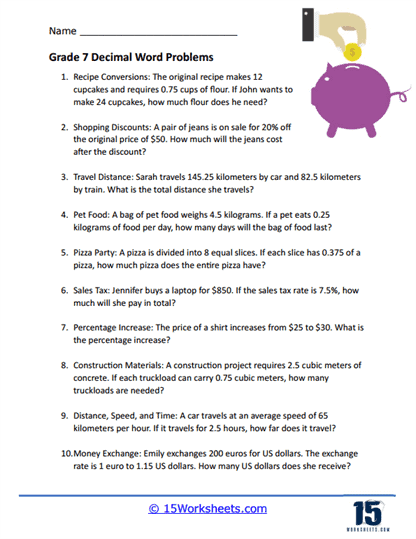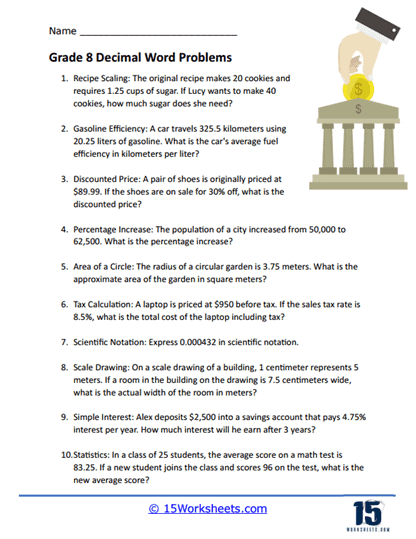Decimal Word Problems Worksheets
About These 15 Worksheets
Decimal word problem worksheets are designed to help students develop their mathematical skills by solving real-world problems that involve decimal numbers. These worksheets typically present scenarios where decimal numbers are used in everyday situations, such as money, measurements, or statistics. Decimal word problems are an essential part of mathematics education as they bridge the gap between abstract numerical concepts and their practical applications in daily life.
These worksheets are structured to challenge students to interpret written information, identify relevant decimal values, and perform arithmetic operations like addition, subtraction, multiplication, or division with decimals. By working through these problems, students not only reinforce their understanding of decimal place value but also develop critical problem-solving skills.
Decimal word problems can cover a wide range of topics and difficulty levels. For example, they might involve tasks like calculating the total cost of items, finding the average of a set of decimal values, converting measurements, or determining percentages in various scenarios. Some problems might require students to make decisions based on decimal calculations, enhancing their ability to apply mathematical concepts to real-life decision-making situations.
Educators often use decimal word problem worksheets as a part of their curriculum to assess students’ comprehension of decimal concepts and their ability to apply these concepts in practical contexts. These worksheets can be tailored to different grade levels, ensuring that students progressively build their skills as they advance in their mathematical education.
What Are Decimal Word Problems?
Decimal word problems are mathematical problems that involve decimal numbers and are presented in the form of worded descriptions or narratives. These problems require the application of decimal operations and concepts to find solutions.
Decimal word problems can cover a wide range of topics and real-life situations, including money, measurements, ratios, percentages, and data analysis. These problems often require understanding the relationships between decimals, performing calculations with decimals, and interpreting the results in the context of the problem.
Here are a few examples of decimal word problems across different contexts:
Money – “Mary went to the store and bought three items. The first item cost $8.95, the second item cost $12.75, and the third item cost $6.50. How much did Mary spend in total?”
Measurements – “A rectangular field has a length of 12.5 meters and a width of 8.75 meters. What is the area of the field?”
Ratios – “In a class of 30 students, 12 students are boys. What is the ratio of boys to girls in the class?”
Percentages – “A shirt is on sale for 25% off its original price of $40. What is the sale price of the shirt?”
Data Analysis – “In a survey of 100 people, 45% said they prefer tea over coffee. How many people prefer tea?”
Problems With Solutions
Problem 1 (Easy): Sara went shopping and bought three items. The prices of these items were $12.95, $5.75, and $8.50. What is the total cost of her purchase?
Solution: To find the total cost, simply add up the prices of the three items:
Total Cost = $12.95 + $5.75 + $8.50
Total Cost = $27.20
So, Sara’s total purchase cost is $27.20.
Problem 2 (Intermediate): A recipe calls for 1.25 cups of sugar. If you want to make 4 batches of the recipe, how many cups of sugar will you need in total?
Solution: To find the total amount of sugar needed for 4 batches, multiply the amount for one batch (1.25 cups) by 4:
Total Sugar = 1.25 cups/batch × 4 batches
Total Sugar = 5 cups
So, you will need 5 cups of sugar in total for 4 batches of the recipe.
Problem 3 (Difficult): A company’s quarterly revenue increased by 18.75% from the first quarter to the second quarter and then decreased by 12.5% from the second quarter to the third quarter. If the third-quarter revenue was $225,000, what was the revenue in the first quarter?
Solution: Let R be the revenue in the first quarter.
In the second quarter, the revenue increased by 18.75%, which can be represented as 1 + 0.1875 = 1.1875 times the first-quarter revenue.
In the third quarter, the revenue decreased by 12.5%, which can be represented as 1 – 0.125 = 0.875 times the second-quarter revenue.
Given that the third-quarter revenue is $225,000, we can set up an equation to find R:
0.875 * (1.1875 * R) = $225,000
First, calculate the value inside the parentheses:
1.1875 * R = $225,000 / 0.875
Now, divide both sides by 1.1875 to solve for R:
R = ($225,000 / 0.875) / 1.1875
R = $225,000 / 0.875 / 1.1875
R = $225,000 / 1.046875
R = $214,736.84
So, the revenue in the first quarter was approximately $214,736.84.
It is essential to pay attention to units of measurement, decimal place values, and any specific instructions or constraints given in the problem. Regular practice with decimal word problems will help improve your problem-solving skills and build confidence in working with decimal numbers in real-life scenarios.
What Types of Jobs and Careers Solve Decimal Word Problems?
These jobs require a strong understanding of decimals and the ability to apply decimal operations in practical situations. Here are a few examples:
Financial Analyst – Financial analysts work with numerical data, including decimal numbers, to analyze financial performance, evaluate investments, and make financial projections. They often deal with decimals when calculating ratios, percentages, returns, and analyzing financial statements.
Accountant – Accountants work with financial records, budgets, and transactions, which involve decimal calculations. They handle decimal numbers when performing calculations for expenses, revenues, taxes, budgets, and financial reports.
Architect or Civil Engineer – Architects and civil engineers use decimals extensively in their work, particularly when calculating measurements, dimensions, quantities, areas, and volumes for construction projects. Decimal accuracy is crucial in designing structures and ensuring proper specifications.
Data Analyst – Data analysts work with numerical data sets, including decimals, to derive insights and make data-driven decisions. They analyze and interpret decimal values when working with statistical data, percentages, ratios, and visualizations.
Scientist or Researcher – Scientists and researchers in various fields, such as chemistry, physics, biology, and environmental science, frequently encounter decimals in their data analysis. Decimal values are crucial for measurements, experimental results, statistical analysis, and mathematical modeling.
Retail Buyer or Merchandise Planner – Professionals in retail buying or merchandise planning often deal with decimal calculations when analyzing sales data, forecasting demand, calculating profit margins, and determining pricing strategies.
Surveyor – Surveyors use decimals when measuring and mapping land, boundaries, and property features. They make precise calculations involving decimal numbers to determine distances, angles, elevations, and land areas.
Quality Control Analyst – Quality control analysts work with decimals when conducting quality inspections, analyzing product specifications, and ensuring compliance with standards. Decimal measurements and calculations are essential for assessing tolerances and product specifications.
Pharmacists – Pharmacists regularly encounter decimals when calculating medication dosages, compounding prescriptions, and managing drug inventory. Precision and accuracy with decimals are critical in pharmaceutical calculations.
Statistician – Statisticians deal extensively with decimal numbers in data analysis, statistical modeling, and hypothesis testing. They use decimals to interpret and communicate findings, calculate probabilities, and perform various statistical calculations.















